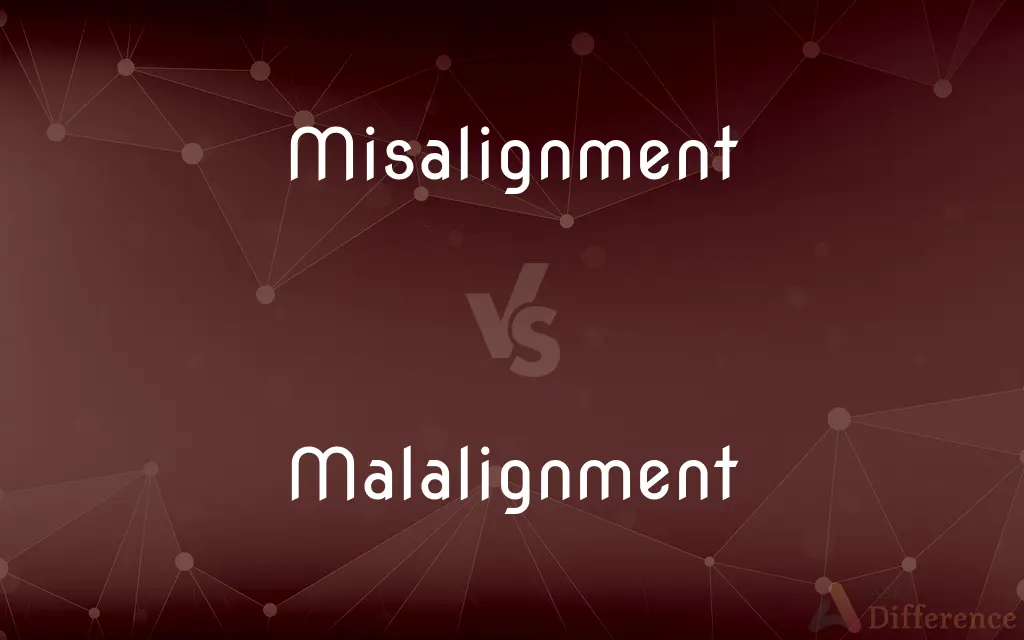Misalignment vs. Malalignment — What's the Difference?
By Tayyaba Rehman — Updated on October 25, 2023
Misalignment refers to incorrect positioning or arrangement, while Malalignment is an improper alignment, especially in anatomical structures.

Difference Between Misalignment and Malalignment
Table of Contents
ADVERTISEMENT
Key Differences
Misalignment and Malalignment are two terms that, while similar in nature, have nuanced differences. Misalignment often denotes an incorrect or unsuitable positioning or arrangement of something. For instance, the misalignment of gears in machinery can cause operational hiccups. On the other hand, Malalignment is typically more specific and frequently refers to the improper alignment of anatomical structures, such as bones or joints.
Misalignment is a more general term and can be applied to a wide array of subjects, both inanimate and animate. For example, one might refer to the misalignment of priorities in a business strategy or the misalignment of teeth in dentistry. Conversely, Malalignment, with its roots often in the medical realm, specifically deals with the skewed or incorrect positioning of parts in relation to one another, particularly in the human body.
In the world of engineering or mechanics, Misalignment might describe the incorrect positioning of two parts meant to fit together seamlessly. A misalignment in this context might lead to inefficiencies or breakdowns. Malalignment, while it could technically be used in these contexts, finds its primary application in the realm of orthopedics or medicine, denoting situations like malalignment of the spine or knees.
Both Misalignment and Malalignment underscore a deviation from an ideal or intended position. While Misalignment can be used in various scenarios ranging from business to machinery, Malalignment is predominantly used when discussing anatomical or physiological deviations.
Comparison Chart
Scope
Broadly applicable to many contexts.
Primarily used in anatomical contexts.
ADVERTISEMENT
Usage
Refers to incorrect positioning or arrangement.
Refers to improper alignment of body parts.
Origins
Used in various fields like engineering, business, dentistry.
Commonly used in the medical field, especially orthopedics.
Applicability
Can be used for both animate and inanimate subjects.
Typically used for anatomical or physiological structures.
Implication
General deviation from intended position.
Specific deviation, often implying a need for medical intervention.
Compare with Definitions
Misalignment
An improper configuration or setup.
A slight misalignment in the telescope hindered clear viewing of the stars.
Malalignment
Improper alignment of anatomical structures.
The doctor diagnosed him with malalignment of the spine.
Misalignment
Incorrect positioning or arrangement of something.
The misalignment of the printer heads caused blurry prints.
Malalignment
The state of being out of line, especially referring to body parts.
Hip malalignment can be corrected with specialized exercises.
Misalignment
The state of not being in correct relation or alignment.
The misalignment of the tiles made the entire floor look uneven.
Malalignment
A deviation from the correct anatomical arrangement.
Malalignment of teeth can affect one's bite and appearance.
Misalignment
A mismatch in position between two or more entities.
The misalignment of the wheels caused the car to veer left.
Malalignment
Incorrect positioning relative to a norm or standard, especially in the body.
A foot malalignment can be the root cause of walking difficulties.
Misalignment
A deviation from the correct order or position.
A misalignment of priorities led to the project's failure.
Malalignment
A mispositioning specifically in a medical or physiological context.
Malalignment of the knee joint can lead to pain and mobility issues.
Misalignment
Incorrectly aligned.
Malalignment
Bad or wrong alignment; misalignment.
Misalignment
The state, or an instance, of being misaligned
Misalignment
The act of aligning improperly or state of being improperly aligned.
Misalignment
The spatial property of things that are not properly aligned
Common Curiosities
Is a misaligned spine the same as a malaligned spine?
They can be used interchangeably, but malaligned is more specific to medical contexts.
Can Misalignment be used in business contexts?
Yes, for instance, to refer to a misalignment of goals or priorities.
How is Malalignment different from Misalignment?
Malalignment is an improper alignment, often in anatomical structures, while Misalignment has broader applications.
What can cause Misalignment in machinery?
Wear and tear, improper assembly, or external forces, among other factors.
What is Misalignment?
Misalignment refers to the incorrect positioning or arrangement of something.
What might result from the malalignment of a joint?
Pain, reduced mobility, and potential long-term damage.
Is Malalignment always medical?
Predominantly, yes. It's most often used in medical or anatomical contexts.
How does Misalignment affect efficiency in machines?
Misalignment can lead to wear, energy wastage, and reduced machine life.
Can I use Malalignment for machinery?
While possible, Misalignment is more commonly used for machinery, and Malalignment for anatomical references.
Can Misalignment be corrected?
Often, yes, depending on the context. For instance, misaligned machinery parts can be readjusted.
Is Malalignment a medical term?
Yes, it's primarily used in medical contexts to describe improper alignment of body parts.
Are Misalignment and Malalignment synonyms?
They are related but not exact synonyms. Misalignment is broader, while Malalignment is more specific, often to anatomy.
Can Malalignment lead to other health issues?
Yes, malalignment in one body part can impact others, leading to compounded health issues.
How is Malalignment diagnosed?
Through physical exams, imaging techniques, and considering patient symptoms.
Is Misalignment always a bad thing?
Generally, it implies an undesired deviation, but context matters. In some cases, it might be inconsequential.
Share Your Discovery

Previous Comparison
Cabin vs. Office
Next Comparison
Cab vs. CobAuthor Spotlight
Written by
Tayyaba RehmanTayyaba Rehman is a distinguished writer, currently serving as a primary contributor to askdifference.com. As a researcher in semantics and etymology, Tayyaba's passion for the complexity of languages and their distinctions has found a perfect home on the platform. Tayyaba delves into the intricacies of language, distinguishing between commonly confused words and phrases, thereby providing clarity for readers worldwide.















































